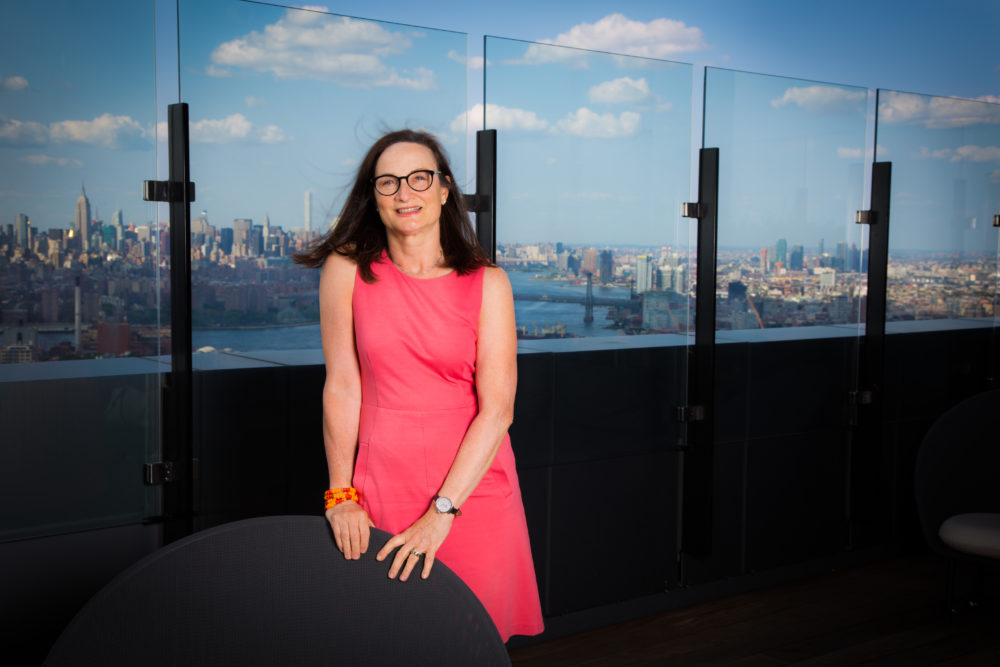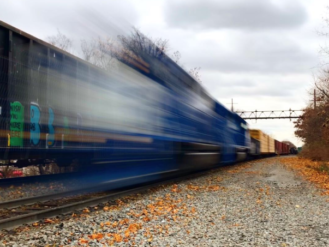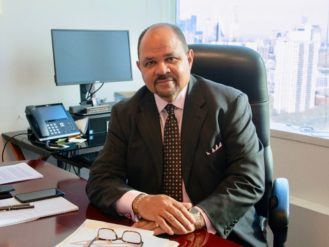Downtown’s Champion Aims to Take It Up a Notch
How Regina Myer, president of the Brooklyn neighborhood's business partnership, plans to keep its remarkable growth on track
Regina Myer, president of the Downtown Brooklyn Partnership, photographed on the roof of The Gotham, on Ashland Place (Photo by Erin Patrice O’Brien)
When Regina Myer took over last October as president of the Downtown Brooklyn Partnership, the neighborhood was already reaching for the sky. Residential skyscrapers had arrived; now comes a wave of office towers. As head of the not-for-profit, membership organization, Myer’s role is to ensure all that development meshes well, from the skyline down to the street level. An urban planner by training, she earlier directed redevelopment of the North Brooklyn waterfront, helped plan Manhattan’s huge Hudson Yards project, shaped the rezoning of Downtown Brooklyn and helmed the creation of Brooklyn Bridge Park. In her new role, Myer, a longtime Park Slope resident, intends to make downtown the most dynamic neighborhood in the city. The Bridge talked with her about her mission:
1. Downtown Brooklyn has really arrived. How did it happen?
You know, Downtown Brooklyn was always the center of the borough. It’s where our county courts are, and our borough president has his seat. But until MetroTech [was built] it didn’t have a real center for offices. What it did have is arguably the best mass transit in the city. The 2004 rezoning [allowing the construction of residential towers] based its vision for the future on a few things. One was that there was room for expansion, especially places like Willoughby Street and Flatbush Avenue. But it also realized that there was so much strength in Brooklyn already to build upon, and that a mixed-use neighborhood with residential [apartments] in a high-rise format would make sense for this area, given the transit system and phenomenal access to culture, parks and shopping.
What we’re seeing now, with all the construction fences coming down, is that we have a true mixed-use neighborhood that’s able to take advantage of all of those aspects. We have new offices coming to locate here. There are finally places to go have lunch and to have a business dinner and a drink after work.
Another thing is the retail. Fulton Street has long been one of New York’s great retail corridors. And it’s seeing a phenomenal resurgence now that we have a Macy’s that’s renovated and with the opening of City Point and its strong package of shopping and dining options that cater to downtown’s diverse population, as well as visitors from across the borough and around the city. There’s a really new, great energy to Fulton Street.
2. Where do you want to take it from here?
I want Downtown Brooklyn to be viewed as New York City’s great, great downtown. And we have so much potential to get there. I think as new buildings open, as new tenants come to Downtown Brooklyn, we also have the ability to focus on the landscape and the streetscape and make sure that the pedestrian environment really ties everything together.
I think we all know that we can be better connected. We can be better connected to the waterfront, for instance. Proposals like the Strand [pedestrian gateway] are very much on our mind because that proposal put forth this idea that the downtown should be connected to the waterfront and to the Brooklyn Navy Yard. Our connections to the Navy Yard can be strong and meaningful as it evolves to a place where there’s more and more job growth. It’s a place where we can provide access to people at Farragut Houses and people at Whitman and Ingersoll houses to the resources of Downtown Brooklyn and the jobs in the Navy Yard. From New Lab [in the Navy Yard] to Metro Tech is not a far walk, but it’s not a pleasant walk right now.
3. What’s your position on big projects like 80 Flatbush Ave.?
I think the brilliance of that proposal is that the Alloy team realized the potential of that site. It’s a large site and it already has a school on the site, a 19th century school building, which is so charming. Alloy put together a proposal that really builds on those strengths, adding space for a second school, and respecting the historic nature the beautiful building on the corner. They also had the foresight to integrate Class A office space into the project, which, in addition to the other infrastructure the project will provide, will really meet a critical need downtown.
What I’d like to promote is that all these large sites should be developed to their potential in terms of mixed use. City Point leads in that way. The development team there also had a large site, a failing mall site. They understood the shopping potential, given its prominent location, but added residential and a modicum of office to that because they understood that this format makes sense.
4. Work has started on Brooklyn’s first supertall. What’s your take?
Well, for one, it’s a tremendously handsome building as designed right now. It’s wonderful to see that caliber of architecture, and to envisage it on Flatbush Avenue, obviously so careful in respecting the exterior and interior landmark of the Dime Savings Bank, the bedrock of Fulton Street. I think that the magic of that tower, though, is that it will be Brooklyn’s tallest. It really could be this phenomenal beacon on Flatbush Avenue. I’m a huge supporter of that project. I think we all feel that it will bring a lot of energy.
5. How hot is the business rivalry of Brooklyn vs. Manhattan?
I’ve lived in Brooklyn since 1991, so I personally think Brooklyn is a better place. [Laughs] But I don’t see this as a rivalry. I think the incredible strength of New York City is that we have great places and we have a lot of them, right? Even 20 years ago, we didn’t have Downtown Brooklyn the way we have it, but also we didn’t have a Flatiron District that was so active.
That’s the magic of New York City: this incredible evolution. But I do think Brooklyn is leading the nation in this idea of rebirth and this idea that coming back to the city can be an incredible, exciting thing to do. To continue to propel that is something that motivates all of us here at the partnership.
6. Not many big Manhattan firms have arrived here yet. Why not?
How could they move here if we don’t have the Class A space available for them? For a few years now we’ve been at a record low commercial-vacancy rate for the area. Right now we’re at around 3%. A main reason for that is the area is really lacking in Class A space. So we’re thrilled to see investment in projects like what Tishman Speyer is doing with the Macy’s space, and the ground-up office projects by the Rabsky Group and JEMB Realty. But even with that lack of space currently online, we’ve had some incredible talent coming to Brooklyn. West Elm, Etsy, Huge, now Gimlet Media, have all made Brooklyn home. I think that’s a pretty impressive roster. And when United Technologies feels the need to be near them, that’s interesting.
Obviously there’s a multitude of tenants who are relocating in Manhattan and we can’t compete for them all, but what we have that’s distinctly different is this subset of companies that really appreciate being in Dumbo and other parts of the Tech Triangle. And they are coming here because they love the culture of Brooklyn. They want to be near their employees or they want their employees to work close to home, or they want to make a statement that they are distinctly different. And that’s the magic to me of West Elm, that they have embodied this idea of Brooklyn in their national branding identity.
7. What have you learned from your earlier projects?
What I’ve learned is the power of connectivity. That’s why I’m spending a lot of time understanding all the projects that are coming online now. Because there’s a whole new energy coming with them. Obviously new people are moving in. There’s new people investing in them. But I really want to understand how they all fit together and make sure that they all add up to a great downtown.
8. How can downtown's prosperity help low-income neighbors?
That’s a huge challenge for everyone, for all New Yorkers, in making sure that everybody has access to schools and everybody has access to jobs, and everybody has access to the great amenities that New York City has to offer. That’s my personal belief. We’re spending a lot of time at the partnership making sure that new schools are built downtown and that everybody has access to them.
In terms of jobs, part of the reason that the city and the mayor has spent so much time this year talking about 100,000 new jobs is because he realizes how important it is for access to jobs for all New Yorkers. Our commitment to continue building commercial uses in Downtown Brooklyn is totally compatible with that.
I’ve wanted to take our great relationships with the schools and make sure that students there have access to what’s going on in Downtown Brooklyn. For instance, a couple of months ago when DeKalb Market Hall was hiring, we made sure that students at City Tech who are in their very strong hospitality department had access to those jobs.
9. Is there a way to give downtown more of a campus feel?
Look, it’s a mixed-use downtown, so it’s never going to feel like an idyllic campus, like we’re in the Berkshires. But I would just posit that students are really part of the downtown and that we, as the leaders in the business community, need to understand the great potential of these students. Not just from their perspective, but even from the self-serving perspective of our hiring needs. The idea that some of these students can be the future leaders of Downtown Brooklyn, that’s what motivates me.
10. What's your position on the controversial BQX streetcar?
I am a huge advocate of BQX. I strongly feel that we have to plan for the future, and transit is really a key to our success. Over the course of my career, I’ve seen that most infrastructure projects take a good deal of time and advocacy to get done. When the Second Avenue subway extended the Q train from my neighborhood in Park Slope to the Upper East Side, I felt, ‘Wow! This is a huge sense of satisfaction. Folks have been thinking about this for decades. It takes a huge amount of energy and time and money to expand our transit system.”
What the light-rail system does is provide a different mode–on-street, not underground–and an alignment that has never been sought by our underground system to connect Brooklyn and Queens. And I think it’s vital. Just standing on Flushing Avenue and seeing the huge amount of bicycle traffic now, proves to me how important it is to connect our neighborhoods.
People are concerned about change, and I understand that. And I think that some people are concerned about some of the financial details of this proposal, which will be unveiled as their technical data is finished. But for me, the idea is that access to transit translates into access to jobs.
11. How important is public entertainment, which you sponsor?
We really care about the public realm. People love to know things are happening in their downtown. I have a New Yorker theory of life, which is that one of the reasons I love New York is that I know how much is going on. I find it just as entertaining to check out what’s going on in the front pages of the New Yorker, whether or not I actually manage to get my tush to them. That’s one of the reasons we love New York.
But bringing that down to the Downtown Brooklyn level, having things that are exciting that happen here is one of the reasons people want to come back. So we just partnered with the Brooklyn Hip-Hop Festival a few weeks ago for a wonderful event right on Fulton Street at Albee Square. At MetroTech Commons, we sponsor yoga and boot camp on Tuesday and Wednesday mornings. On Thursdays after work, we’ve started ping pong. In September, we’ll be doing Salsa Wednesdays out at Willoughby Plaza. I think people are delighted to be part of a scene where some crackling things happen.
12. How do you envision Downtown Brooklyn's far-off future?
One thing is how important tech is to the future of downtown, and how important I think experimentation and innovation is for Downtown Brooklyn. We’re also going to be working with NYU as they pursue commercial applications for augmented reality and virtual reality and make sure our members are up to date on that. We’ve been so impressed with what David Belt and his team are doing at the New Lab at the Navy Yard, and we really hope downtown can complement that work through what NYU and others are doing. There’s a real opportunity for synergy there.













